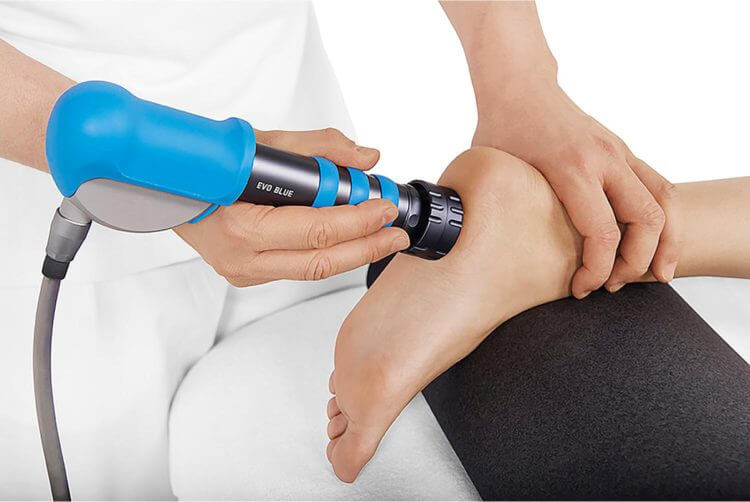
Dry needling helps restore unrestricted and healthy movement. It uses fine ‘dry’ needles to release the knots (trigger points) that can otherwise cause tightness, pain and contribute to injuries. We often use dry needling as an adjunct to your treatment plan to help you get the best results.
If you’re experiencing pain or have an injury, you may have associated trigger points in the surrounding muscles. Trigger points are sensitive, tight knots within muscle bands that can cause pain in the spot itself and other areas of the body.
Dry needling is a treatment that targets these trigger points to help resolve them. It allows muscles to effectively lengthen and contract through their full range of motion rather than a reduced range when the trigger point is present. The improvement in the range of motion can be seen immediately after the treatment, with muscle relaxation being a delayed effect.
Many people experience trigger point knots as muscular tension or muscular aches. High loads on these tight muscles (like increasing the intensity or duration of exercise in a way your body is not used to) can lead to injuries.
Before you worry about pain or discomfort, the sensation of dry needling is nothing like having actual needles inserted like you would with an injection. The term ‘dry’ needling refers to the fact that no liquid can travel through the needles - instead, they are just fine needles (much like acupuncture needles) that easily enter the skin. Some people barely feel anything with the needles, and others experience a mild tingling or sharp sensation. Any discomfort is very temporary, lasting for only up to 24 hours after which you’ll experience muscular relaxation and pain relief.
Our podiatrists take safety, hygiene and sterilisation processes very seriously. To start, we’ll use our (gloved) hands to palpate the exact location of the knots. Next, we’ll use an alcohol wipe to sterilise the area where the needle is inserted. We’ll insert the needle for five to ten seconds to stimulate nerve fibres within the muscle, which will send signals to and from the brain. The muscle receives a signal back by way of a soft tissue twitch response or a spasm to help "work out the knot". As a general rule, the greater this twitch response, the better the outcome. Like anything invasive, an inflammatory response soon follows, initiating the healing processes and the muscle tension relief.
There have been a lot of evidence-based dry-needling studies undertaken that have proven the effectiveness of dry needling. They show immediate and short-term improvements in pain and disability (movement restrictions) following the procedure.
Wondering about the difference between dry needling and acupuncture? Although they may appear similar, there are a number of key differences that separate dry needling and acupuncture. Acupuncture is based on traditional Chinese medicine, which uses points around the body to restore chi and balance, helping to relieve pain or discomfort. Medical doctors who specialise in traditional medicine usually do acupuncture.
Dry needling is based on Western medicine and is supported by evidence-based research to isolate and treat palpable trigger points. We use the same fine needles as acupuncture, but dry needling involves targeting these muscular trigger points to release tension. This helps to restore the muscle to its healthy functionality.
Dry needling can help with many kinds of pain, including foot, knee, lower back, neck, and shoulder pain.
Remedial massage is a massage technique used to treat musculoskeletal issues by applying sustained pressure using slow, deep strokes to
target muscles and tissues. Both massage and needling aim to achieve the same outcome but dry needling is quicker, only lasting five to ten
seconds. If you are looking for a faster solution with immediate benefits, dry needling is the go-to.
Common conditions we use dry needling to help with include:
Dry Needling can be used by itself or as an adjunct therapy to treat any musculoskeletal condition. This means it can be highly effective in reducing your pain and speeding up your recovery from a range of injuries and conditions in conjunction with other primary treatments such as custom orthotics, foot mobilisation therapy, strengthening and stretching exercises and shockwave therapy.
We recommend discussing your medical history with one of our Brisbane-based podiatrists before starting treatment, as there are a number of conditions and lifestyle factors that should be considered before going ahead with dry needling. Dry needling may not be suitable under some conditions:
Visit one of our Brisbane Podiatry clinics
If you would like to talk to one of our team, visit us at one of two Brisbane based locations, CBD & Newmarket.

Shockwave is a new and advanced, non-invasive treatment for painful foot and leg problem like plantar fasciitis, Achilles tendinopathy, shin
splints, knee pain & more.

Custom foot orthotics are special shoe inserts that can help treat a number of common foot concerns. Our podiatrists recommend custom-made
orthotics as these are designed specifically for your feet, helping to support the natural shape of your foot, and improve your overall
posture and foot function.
| Monday | 7:40am - 6:00pm |
| Tuesday | 7:40am - 6:00pm |
| Wednesday | 7:40am - 6:00pm |
| Thursday |
7:40am - 6:00pm |
| Friday | TEMP CLOSED |
| Saturday | CLOSED |
| Sunday | CLOSED |
Ground Floor, 344 Queen Street,
Brisbane City QLD 4000
| Monday | 7:40am - 6:00pm |
| Tuesday | 7:40am - 6:00pm |
| Wednesday | 7:40am - 6:00pm |
| Thursday |
7:40am - 6:30pm |
| Friday | 7:40am - 5:00pm |
| Saturday | 7:40am - 4:30pm |
| Sunday | CLOSED |
Newmarket Village, 114/400 Newmarket Rd, Newmarket QLD 4051